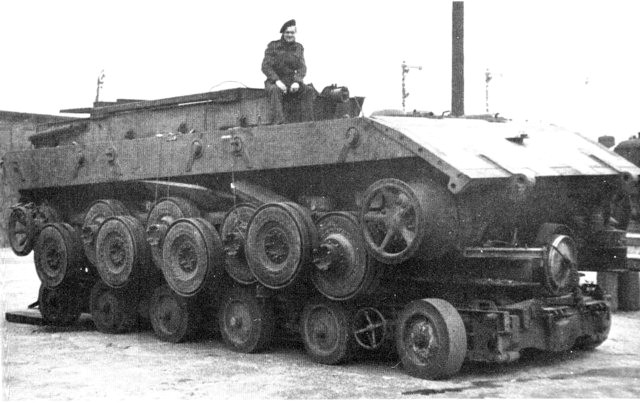Panzer E-100 on:
[Wikipedia]
[Google]
[Amazon]
The ''Panzerkampfwagen'' E-100 (Gerät 383) (TG-01) was a German
hyperlink
/ref> According to the blueprints, the tank would be armed with a both a 150 mm gun and a 75 mm gun. Two types of engines were proposed: one was a 700 hp Maybach HL230, with a transmission and turning mechanism borrowed from the Tiger II. The estimated top speed was . The second variant would have a new 1200 hp Maybach engine and a top speed estimated at . The design had removable side skirts and narrow transport tracks to make rail transport more viable. This design was very similar to the original 'Tiger-Maus' proposal, but had larger diameter road wheels and a new coil spring based suspension rather than the original torsion bars. A new turret was designed; intended to be simpler and lighter than the Maus turret. But many sources also suggest that a Maus turret could be mounted. In July 1944 Hitler ordered the development of super heavy tanks to stop. Work on the E-100 continued at a very low priority, with only three Adler employees available to assemble the prototype. The first prototype was never fully completed and was found by the 751st Field Artillery Battalion of the American forces in April 1945. The partially completed vehicle was taken by the British Army for evaluation and then scrapped in the 1950s.
super-heavy tank
A super-heavy tank or super heavy tank is any tank that is notably beyond the standard of the class heavy tank in either size or weight relative to contemporary vehicles.
Programs have been initiated on several occasions with the aim of creati ...
design developed towards the end of World War II. The largest of the ''Entwicklung'' series of tank designs intended to improve German armored vehicle production through standardization on cheaper, simpler to build vehicles.
By the end of the war, the chassis of the prototype E-100 had been partially completed; it was shipped to the United Kingdom for trials, but was later scrapped.
Development
The basic design was ordered by the '' Waffenamt'' as a parallel development to the Porsche ''Maus'' in June 1943. It was the heaviest of the ''Entwicklung'' (E) series of vehicles, meant to standardize as many components as possible, in the 100 ton weight class; other designs were the E-10, E-25, E-50, E-75. In March 1944, theAdler
Adler may refer to:
Places
*Adler, Alabama, an unincorporated community in Perry County
*Adler Planetarium, Chicago, Illinois, USA
*Adler Township, Nelson County, North Dakota, USA
*Adler University, formerly Adler School of Professional Psycholo ...
company in Frankfurt submitted blueprint 021A38300 for a super-heavy tank called E-100, after the tank was proposed in April 1943 along with the other ''Entwicklung'' series vehicles.Merriam Press, ''World War 2 In Review: German Fighting Vehicles, Issue 2'', October 2019, hyperlink
/ref> According to the blueprints, the tank would be armed with a both a 150 mm gun and a 75 mm gun. Two types of engines were proposed: one was a 700 hp Maybach HL230, with a transmission and turning mechanism borrowed from the Tiger II. The estimated top speed was . The second variant would have a new 1200 hp Maybach engine and a top speed estimated at . The design had removable side skirts and narrow transport tracks to make rail transport more viable. This design was very similar to the original 'Tiger-Maus' proposal, but had larger diameter road wheels and a new coil spring based suspension rather than the original torsion bars. A new turret was designed; intended to be simpler and lighter than the Maus turret. But many sources also suggest that a Maus turret could be mounted. In July 1944 Hitler ordered the development of super heavy tanks to stop. Work on the E-100 continued at a very low priority, with only three Adler employees available to assemble the prototype. The first prototype was never fully completed and was found by the 751st Field Artillery Battalion of the American forces in April 1945. The partially completed vehicle was taken by the British Army for evaluation and then scrapped in the 1950s.

See also
*List of prototype World War II combat vehicles {{Short description, none
''This list contains combat vehicles which never left the design phase or had an extremely limited production (usually < 10).''
Australia
* Entwicklung series *Maus
''Maus'' is a graphic novel by American cartoonist Art Spiegelman, serialized from 1980 to 1991. It depicts Spiegelman interviewing his father about his experiences as a Polish Jew and Holocaust survivor. The work employs postmodern technique ...
German 188 ton design, superior in terms of armor, but inferior in terms of mobility
Tanks of comparable role, performance and era
* American T30 Heavy Tank * Soviet IS-7 post-war heavy tankReferences
Sources
* Chamberlain, Peter & Doyle, Hilary (1999) "Encyclopedia of German Tanks of World War Two" External LinksLost to the Scrapyard, the E-100 , Cursed by Design, ConeOfArc
{{WWII tanks, style=wide
Super-heavy tanks
World War II tanks of Germany
ru:E-серия#E-100